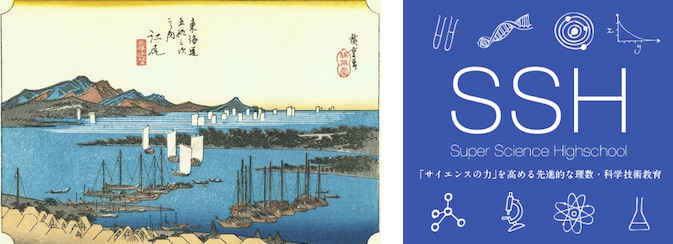Super Science Highschool @ Shizuoka Kita

Shizuoka come vista da Hiroshige - SSH alla Shizuoka Kita High School
U. Hiroshige, Ejiri (ora porto di Shimizu nella Prefettura di Shizuoka), da Le 53 stazioni lungo la strada Tōkaidō dall'odierna Tokyo a Kyoto (1833-1834) - Immagine Wikipedia
IL PROGETTO SUPER SCIENCE HIGHSCHOOL (SSH)
Il progetto Super Science Highschool (SSH) del Ministero della Istruzione, Cultura, Sport, Scienza e Tecnologia (MEXT) giapponese è volto allo sviluppo di una base didattica per la formazione di cittadini scientificamente colti, nonché scienziati e ingegneri che abbiano successo nell'industria locale, nella scienza e nella cultura. L'applicazione a tutti i gradi della Scuole Medie Inferiori associate al progetto iniziò nel 2010 e fu completata nel 2012. La Scuola iniziò così a creare un sistema di educazione combinato. In particolare, fu condotta una ricerca di base sulla qualità delle acque e furono create classi basate sulla metodologia CASE (Cognitive Acceleration through Science Education), sviluppata al King's College di Londra secondo la teoria cognitiva di Jean Piaget (1896-1980).
Le attività principali del progetto coltivano l'atteggiamento positivo degli studenti verso la scienza mediante classi basate sulla sperimentazione, nutrendo la loro capacità di formulare un tema di ricerca (domanda) osservando la natura e di svilupparlo mediante un'indagine ambientale combinata con indagini statistiche, e addestrandoli a prendere decisioni appropriate in base a giudizi scientifici. In aggiunta a questo, la vera ricerca scientifica è fatta conoscere agli studenti attraverso collaborazioni con Università e Istituti di ricerca e sono allenate le loro capacità linguistiche in inglese come elemento per far sviluppare abilità nella discussione e assicurare un successo nella comunicazione in ambienti internazionali.
SSH ALLA SHIZUOKA KITA HIGH SCHOOL
La Shizuoka Kita High School fu nominata "Super Science High School" per il periodo 2007-2011 e ha fatto uno grande sforzo per educare studenti che possano condurre una ricerca scientifica con continuità e autonomia, presentare e comunicare le loro ricerche in modo appropriato, e che possano operare in ambienti internazionali. Nel 2012, la sua nomina fu confermata per altri 5 anni. La Shizuoka Kita High School offre una serie di opportunità din apprendimento baaate sulla ricerca scientifica: presentare una ricerca, mirando a profondità e ampiezza tramite una rete con le altre Super Science High Schools, visitare università e istituti di ricerca in Giappone e all'estero. Tutto si traduce in esperienza diretta degli studenti. Una importante opportunità è fornita da SKYSEF (Shizuoka Kita Youth Science Engineering Forum) dove la Scuola invita studenti giapponesi e stranieri a presentare e discutere le loro ricerche. Viene così promossa la scienza e la comunicazione scienfifica e culturale, fornita agli studenti una importante opportunità in un confronto internazionale e offerta ai docenti la possibilità di condivisione esperienze e idee nella supervisione delle ricerche degli studenti. Tutto questo fornisce un modello per formare cittadini scientificamente colti, oltre a contribuire ad una attititude positiva della società verso tematiche emergenti in materia di scienza e tecnologia.
